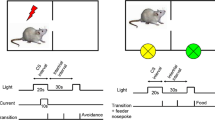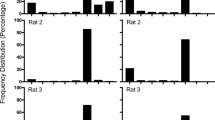Abstract
Four Ss (rats) were given 3000 trials under a discriminated avoidance training schedule in a lever pressing apparatus. The warning period was correlated with silence, and a 5 sec. intertrial interval was indicated by a buzzer. For three Ss the warning period was gradually increased over sessions from 1 sec. to 16 sec, and to 32 sec. for the fourth S. On a few sessions the distinction between the warning signal and inter-trial interval was eliminated and then reinstated; this tested for stimulus control. Measures of response latency to the warning stimulus and of response holding times were obtained. The results showed that percentage avoidance increased with the length of the warning period and was negatively correlated with the Ss’ lever holding behavior. Latencies of avoidance response fell at the mid-point of the warning periods investigated.
Similar content being viewed by others
References
BUGELSKI, B. R., & COYER, R. A. 1950. Temporal conditioning and anxiety reduction in avoidance learning. Amer. Psychol., 5, 264–265. (Abstract).
D’AMATO, M. R., KELLER, D., & DiCARA, L. 1964. Facilitation of discriminated Aavoidance learning by discontinuous shock. J. comp. Physiol. Psychol., 58, 344–349.
DILLOW, P. V., & HURWITZ, H. M. B. 1967. The safety signal in discriminated avoidance. Paper read to S.E.P.A., Atlanta.
DINSMOOR, J. A., MATSUOKA, Y., & WINOGRAD, E. 1958. Bar holding as a preparatory response in escape-from-shock training. J. comp. Physiol. Psychol., 51(5), 637–639.
HEARST, E., & WHALEN, R. E. 1963. Facilitating effects of D-Amphetamine on discriminated-avoidance behavior. J. comp. Physiol. Psychol., 56(1), 124–124.
HULL, C. L. 1943 Principles of behavior. New York: Appleton-Century-Crofts.
HURWITZ, H. M. B. 1964a. Method for discriminated avoidance training. Science, 145, 1070–1071.
HURWITZ, H. M. B. 1964b. Discriminated avoidance training in rats. Science, 146, 1600.
HURWITZ, H. M. B., & DILLOW, P. V. 1966. The effect of strain of rats on the acquisition of discriminated avoidance response. Psychonomic Science, 6(9), 401–402.
HURWITZ, H. M. B., & DILLOW, P. V. 1967. The effects of the warning signal on response characteristics in avoidance learning. Paper for symposium on Discrimination Learning, Sussex University, London.
KAMIN, L. J. 1965. Temporal and intensity characteristics of the conditioned stimulus. In William F. Prokasy (Ed.), Classical conditioning. New York: Appleton-Century-Crofts.
KISH, G. B. 1955. Avoidance learning to the onset and cessation of conditioned stimulus energy. J. exp. Psychol, 50, 31–38.
LEVINE, S., & ENGLAND, S. J. 1960. Temporal factors in avoidance learning. J. comp. physiol. Psychol., 53, 282–283.
MYERS, A. K. 1960. Onset vs. termination of stimulus energy as the CS in avoidance conditioning and pseudo-conditioning. J. comp physiol. Psychol, 53, 72–78.
MEYER, D. R., CHO, C., & WESEMAN, A. 1960. On problems of conditioning discriminated lever-press avoidance responses. Psychol. Rev, 67, 224–228.
MIGLER, B. 1963. Bar holding during escape conditioning. J. exp. Anal. Behav, 6, 65–72.
PEARL, J., & EDWARDS, R. E. 1962. Delayed avoidance conditioning: warning stimulus (CS) duration. Psychol. Reports, 11, 375–380.
Author information
Authors and Affiliations
Additional information
The experiment was supported by a grant from the Medical Research Council, United Kingdom, and the preparation of this report was made possible by Grant GB-5379 from NSF.
The experiments were run during the summer of 1965 shortly before both authors transferred from Birkbeck College, London, to the University of Tennessee.
Rights and permissions
About this article
Cite this article
Hurwitz, H.M.B., Dillow, P.V. Avoidance and Response Duration as a Function of the Length of the Warning Period. Psychol Rec 17, 517–524 (1967). https://doi.org/10.1007/BF03393727
Published:
Issue Date:
DOI: https://doi.org/10.1007/BF03393727




